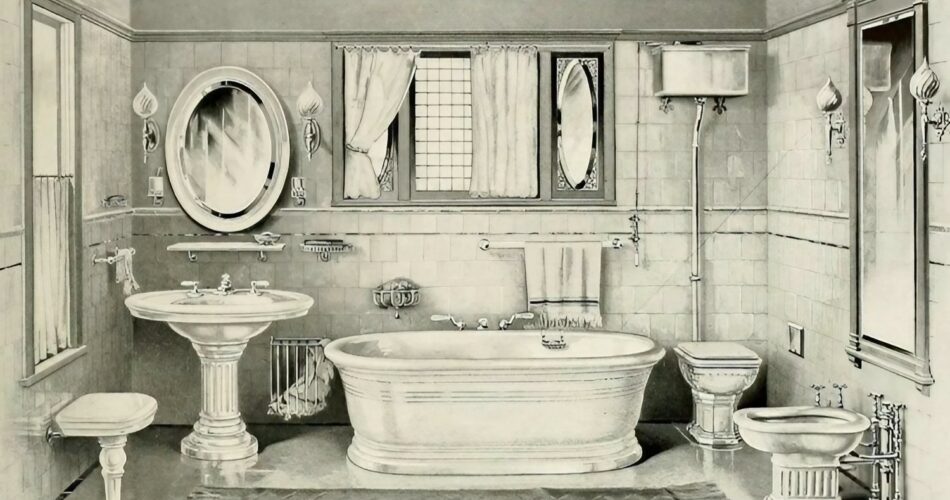They were uncomfortable but also risky
The Victorian era saw significant technological advancements along with appalling health and safety regulations. Humans used asbestos in their construction, drank water from lead pipes, and turned their toilets into dreadful deathtraps.
You can scarcely blame the Victorians for seeking a simple fix to cold bathrooms that didn’t entail using a stove because life without hot water must have been rather miserable. One of the remedies they came up with, though, occasionally turned out to be lethal. The bathtub itself was heated, much like you would a saucepan, as opposed to heating the water separately and piping it into the bath.
1. Hot water and gas vapors
Benjamin Waddy Maughan created the geyser heating system in the United Kingdom in 1868. This gas burner could be installed under the bath, allowing users to heat the water directly. The issues with this technology, which may possibly reach scorching temperatures or even boil someone alive, are obvious to those of us with some common sense.
According to this article, baths may become quite hot, and the gas vapors produced by the burner may also pose major risks. For instance, a tale from the Edinburgh Evening News in 1888 describes a man who appeared to have choked on gas vapors in his bathroom before passing out in the bath. He was cooked alive like a lobster while he was unconscious. Not only was the bathwater boiling when he was found, but the bathroom’s pipes had also melted.
2. Poisonous soap
In addition to the hazardous plumbing and heating, Victorian England’s bathrooms frequently contained products poisoned with arsenic. People in the 19th century enjoyed adding arsenic to things, including soap, for a variety of reasons. At the time, arsenic produced a lovely shade of green that was quite trendy, and it was also employed in cosmetics to whiten skin. Arsenic wasn’t regulated in Britain until 1903, even though individuals had begun to notice something was wrong with the dangerous powder by the 1860s.
Even certain products offered doctor-approved safety guarantees. The Wellcome Collection states that Dr. McKenzie’s arsenic soap was promoted as having an “absolutely harmless” amount of arsenic to promote healthy skin. This claim is particularly amusing and terrifying, given that arsenic poisoning can result in horrifying skin sores as well as death. Regrettably, there were other risks associated with Victorian baths.
3. Terrifying toilets
Even though the 19th century saw significant advancements in sanitation, early Victorian plumbing and sewage systems were far from ideal. In London, the River Thames was filled with sewage, and people used cesspools to dump their waste. Yet, in addition to being unpleasant, trash disposal might also be highly dangerous because of the buildup of explosive gases. It wasn’t unusual for the cesspits in London to occasionally catch fire.
Cesspools were frequently located in the basements of homes, where it was assumed that the scent would be contained and out of reach. The toilet was positioned above the foul chamber, and the poorer you were, the closer the waste ended up to your living quarters. It might be risky to keep candles or gas lamps so close to the bathroom. The accumulation of methane and hydrogen sulfide in some people’s homes might occasionally cause toilets to spontaneously combust.
4. Lead
Lead is a soft, malleable substance that has historically been used to make pipes, particularly in the Roman and Victorian eras. According to The New Statesman, lead was formerly so widely used that the word “plumbing” really stems from the Latin word “plumbum”, which means lead. It might be used to solder toilet cisterns to walls, solder paint to pipes, and many other things. This is excellent if you want to make your bathroom bomb-proof, but not so great if you want to stay healthy.
In addition, exposure to lead can be disabling. If you ingest it or breathe it in, it can harm your neurological system and even lower your IQ. If you are exposed to it for a long enough period, it will also kill you, according to the World Health Organization. People started to realize this in the late Victorian era when lead-contaminated environments and particularly lead-contaminated water caused individuals to become seriously ill. For instance, it was discovered that lead pipes and lead-tainted drinking water were to blame for a mass poisoning that occurred in Sheffield in 1889. Similarly to this, lead hot water pipes in Philadelphia, Pennsylvania, were determined to be the source of major sickness there.
Lead pipes were still used in the United States until the 20th century, even though the dangers of lead on humans were widely known in the 19th century because it was so convenient for the Victorians. In the US and the UK, lead was employed on such a large scale that pipes are still being removed today.
